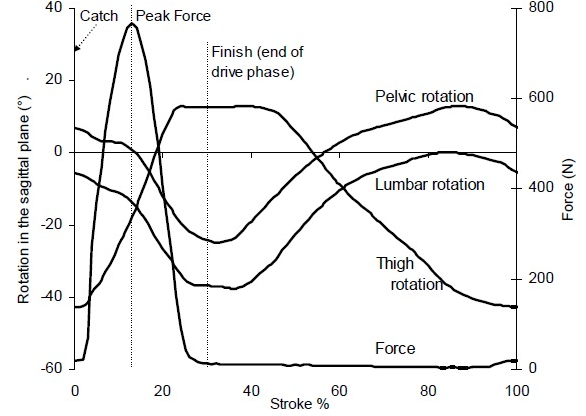The Journey towards Rowing Gold at the Olympics
Key MSk MEC Researchers: Prof. Alison McGregor & Prof. Anthony Bull
Compiled by Dr Gifty Tetteh, MSk MEC Centre Manager, Imperial College, London
From Sports Innovation, Technology and Researchand research papers from the McGregor and Bull labs
The Olympics is considered the ultimate international sporting event where elite athletes across the globe compete to very fine margins. The MSk MEC’s research journey with the GB rowing team has evolved over the last 18 years. Prior to our involvement in 2000, the team won two medals in the 1996 games with a 7th overall position. This improved to three medals and 3rd overall position in 2000, four medals and 3rd overall position in 2004, six medals and 1st overall position in 2008, nine medals and 1st overall position in 2012 and five medals and 1st overall position in 2016.
We are proud that our involvement with the GB team has contributed to great success and improved their overall performance at various Olympic Games. Moreover, Team GB’s rowing success at the London 2012 games influenced participation in the sport, with over 32,000 people signing up for rowing courses in the UK, and 1000 new applicants to the GB Rowing’s START talent ID programme, which is seen as a gateway to elite performance.
Biomechanics, the study of the mechanical structure and function of biological systems, is fundamental to most of the research being carried out in the MSk MEC. Rowing is a motor skill that requires a high level of consistency, coherence, accuracy and continuity. Hence the repetitive nature of the rowing stroke makes it ideal for detailed biomechanical analysis.
With an initial focus on injury prevention rather than performance enhancements, our research has demonstrated a clear link between the two; because by understanding how and why injuries occur, we can impact performance by preventing injuries. Research from the McGregor and Bull labs at Imperial College has also been able to identify characteristics of the rowing stroke and some potential sources of poor techniques as shown in Figure 1, Steer et al. Also, concurrent studies using an interventional Magnetic Resonance Imaging (MRI) scanner, highlighted the importance of considering the entire lumbo-pelvic motion during rowing rather than spinal motion in isolation, McGregor et al.1.

Figure 1: An example of an average rowing stroke including force produced, lumbo-thoracic, lumbo-sacral (pelvic) and femoral rotation from an individual athlete from Steer et al., J Sports Sci Med 2006 Mar; 5(1): 52-59
More importantly, findings from McGregor et al.2 suggested that, it is possible to make athletes more biomechanically efficient for the same physiological work load, and thus have a direct impact on performance. They showed this by improving trunk strength and control, whilst changing the biomechanics technique and optimising the use of the pelvic during a rowing stroke. These findings changed the focus of rowing research from injury prevention to performance impact. It also allowed our researchers to develop a new set up approach that was used over an Olympiad to test and provide feedback to the elite women’s and lightweight men’s and women’s GB rowing team.
A biofeedback tool that provides visual real-time biofeedback and biomechanical summaries to athletes and support staff has been developed by our researchers as part of a 14-year study. The tool acquires, analyses and interprets data in real time. Data collection includes force at the handle, kinematics of the lumbar spine, pelvis and lower limb, power and handle position, seat loading and seat centre of pressure, and foot symmetry. This biofeedback tool for ergometer rowing was adopted by the British elite rowing squad that represented the UK at both World Championships and Olympics. The athletes rated feedback from the tool highly, and it appeared that one of its greatest strengths was in becoming a common language between the coach, support staff, scientist and athletes, McGregor et al.3.
We are delighted that research from the McGregor and Bull labs has had an impact on rowing, and we propose that similar approaches can be used for other sports, particularly those with a repetitive nature such as cycling and running.
 |
 |
| Alison McGregor is a Professor of Musculoskeletal Biodynamics in the Department of Surgery and Cancer. Her research focusses on understanding the mechanism of injury, effects of injury and function, as well as injury management. She carried the Olympic torch on behalf of Imperial College in 2012, and has worked on various musculoskeletal research projects. | Anthony Bull is Professor of Musculoskeletal Mechanics and the Head of the Bioengineering Department at Imperial College. His research focuses on the basic mechanics of joints, and its application to the diagnosis and treatment of pathologies and performance parameters in areas including Sport and Injury Biomechanics, and the Biomechanics of Ageing. |
| Some of her current projects include: | Some of his current projects include: |
|
|
For more information on the MSk MEC rowing research, please see:
- Steer RR, McGregor AH, Bull AMJ. (2006), Repeatability of kinematic measures of rowing performance and their use to compare two different rowing ergometers. Journal of Sports Science & Medicine 55, 52-59.
- McGregor A., Anderton L., Gedroyc W., (2002) The assessment of intersegmental motion and pelvic tilt in elite oarsmen. Med Sci Sports Exerc 34(7): 1143-9.
- Holt PJ, Bull AM, Cashman PM, McGregor AH. (2003), Kinematics of spinal motion during prolonged rowing. Int J Sports Med 24(8): 597-602.
- O’Sullivan F, O’Sullivan J, Bull AM, McGregor AH. (2003), Modelling multivariate biomechanical measurements of the spine during a rowing exercise. Clin Biomech (Bristol, Avon) 18(6): 488-93.
- McGregor AH, Patankar ZS, Bull AMJ (2007), Longitudinal changes in the spinal kinematics of oarswomen during step testing. Journal of Sports Science and Medicine 6(1): 29-35.
- McGregor AH, Buckeridge E, Murphy AJ, Bull AMJ. (2016), Communicating and using biomechanical measures through visual cues to optimise safe and effective rowing. Proc. IMechE Part P Sports Eng. Tech. 230(P), 246-252.
- McGregor AH, Bull AM, Byng-Maddick R (2004), A comparison of rowing technique at different stroke rates: a description of sequencing, force production and kinematics. Int J Sports Med 25(6): 465-70.
- Bull AM, McGregor AH (2000) Measuring spinal motion in rowers: the use of an electromagnetic device. Clin Biomech (Bristol, Avon) 15(10): 772-6.
- Bull AMJ, Holt PJ, Wragg P, McGregor AH. (2004), Validation of the use of a skin-mounted device to measure out-of-plane rotations of the spine for a rowing activity. J. Musculoskeletal Res. 8, 129-132.
- McGregor AH, Patankar Z, Bull AMJ. (2005), Spinal kinematics in elite oarswomen during a routine physiological step test. Med. Science Sports Exer. 37, 1014-1020. Q1
- McGregor AH, Patankar ZS, Bull AMJ. (2008), Do men and women row differently? A spinal kinematic and force perspective. Proc. IMechE Part P Sports Eng. Tech. 222(P), 77-83.
- Buckeridge E, Hislop S, Bull AMJ, McGregor AH. (2012), Kinematic asymmetries of the lower limb during ergometer rowing. Med. Science Sports Exer 44, 2147- 2153.
- Buckeridge EM, Bull AMJ, McGregor AH. (2014) Biomechanical determinants of elite rowing technique and performance. Scan J Med Sci Sports 25, e176-83. PMID: 25039605
- Buckeridge EM, Bull AMJ, McGregor AH. (2016), Incremental training intensities increases loads on the lower back of elite female rowers. Journal of Sports Sciences 34, 369-378. PMID: 26090702
- McGregor AH, Buckeridge E, Murphy AJ, Bull AMJ. (2016), Communicating and using biomechanical measures through visual cues to optimise safe and effective rowing. Proc. IMechE Part P Sports Eng. Tech. 230(P), 246-252.
- Buckeridge E, Bull AMJ, McGregor AH. (2016), Influence of foot-stretcher height on rowing technique and performance. Sports Biomechanics 15, 513-526.
Join the MSk Network
Sign up to our Technology Network to receive information about events, news and funding opportunities.
Join the discussion on LinkedIn
Follow MSkMEC on LinkedIn